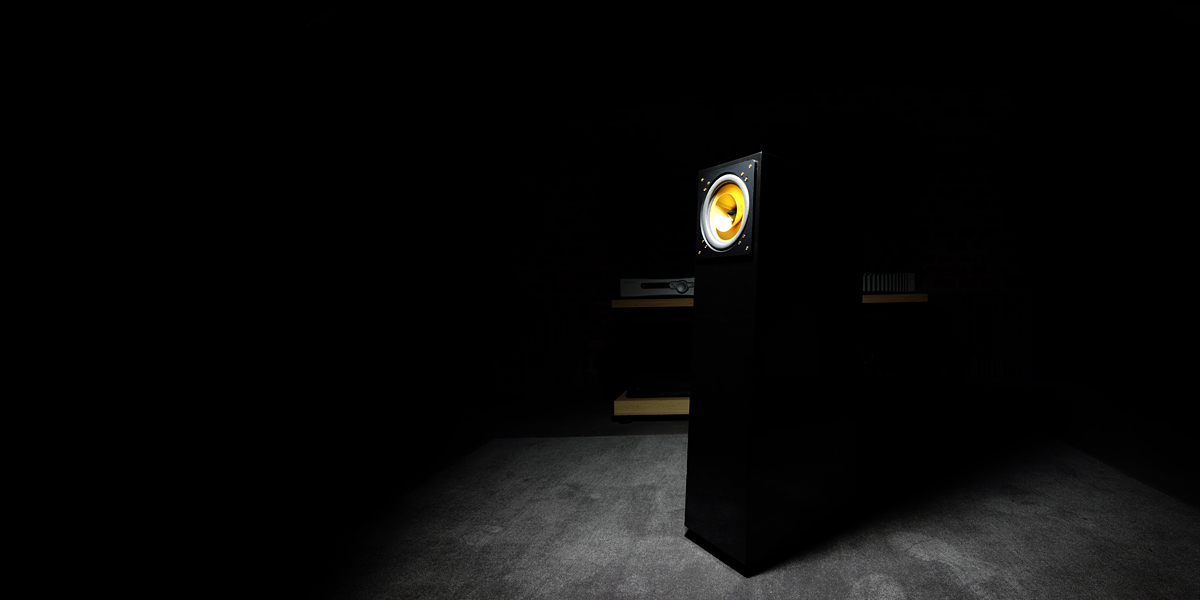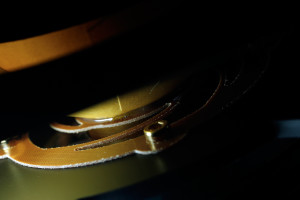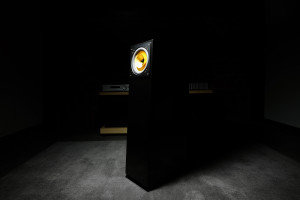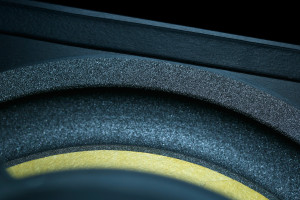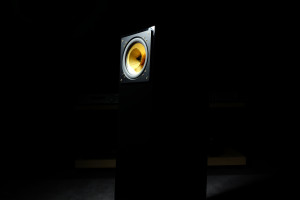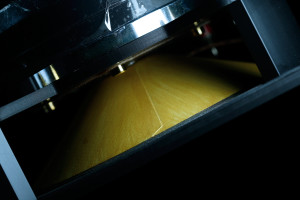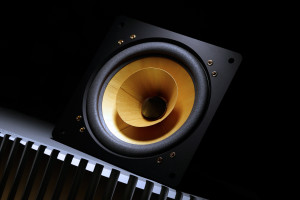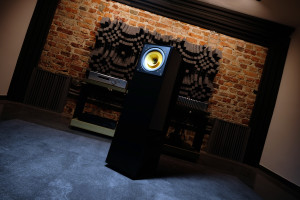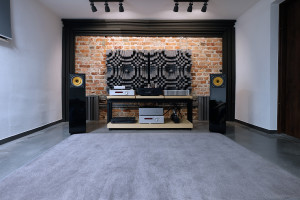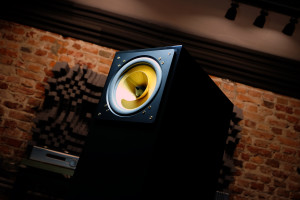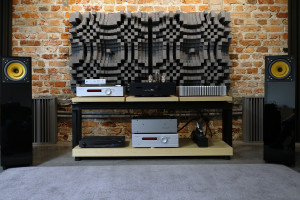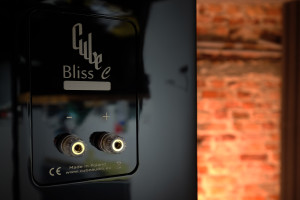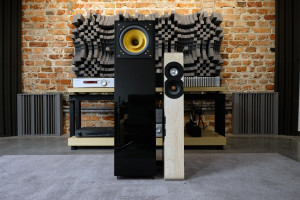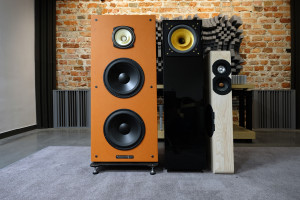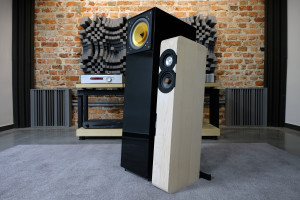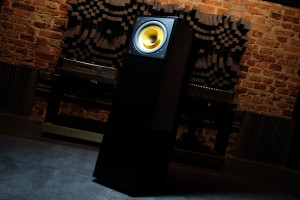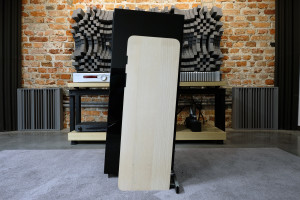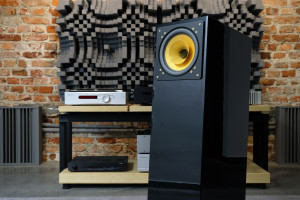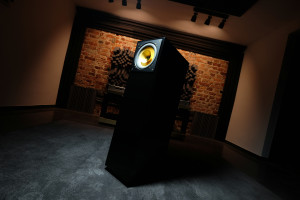The full-range game is hard, played by very few manufacturers. Those who roll with their own drivers of the sort are even fever. Hence when such a niche company emerges, curiosity arises and this review is the attempt to satisfy it. Cube Audio Magus speakers loaded with this operation’s proprietary TOTL full-range F8 Magus transducers are this writing’s hero. Enjoy!
Introduction
Early October 2017 Srajan wrote:
“You should take a listen to the Cube Audio Bliss C. I predict a *very* different experience from the Voxativ Zeth. And, not yet public, they’re 90% ready with a new drop-in driver that’s supposed to be even better than what I heard…”.
The ‘new drop-in driver’ the 6moons.com main man mentioned? This exactly landed at my place a good while ago. Yet let me explain first that this gent’s audio related opinions are – in my book at least – very accurate. Thanks to his work and suggestions I got myself familiarized with i.e. Boenicke W5 and FirstWatt F7 and – as an owner of both – couldn’t be any happier. This time around there was a major catch early on, though. Voxativ Zeth and Cube Audio Magus are of similar sort and my initial experience with the former was, to put it mildly, mediocre at best. Not having any typical valve amplifier on hand, which was needed badly in the German case, disbelief was surely there. Still, Srajan’s recommendation I couldn’t ignore. Maybe he discovered something special again? It was time to perform yet another leap of faith, the man himself pushed me efficiently to do so. Inner curiosity eventually kicked-in hard, a phone call was made and cogs were on the move shortly after. The audition during the local Audio Video Show was the next step and once this event ended, two rather large boxes were delivered to my cave directly by the Cube Audio team.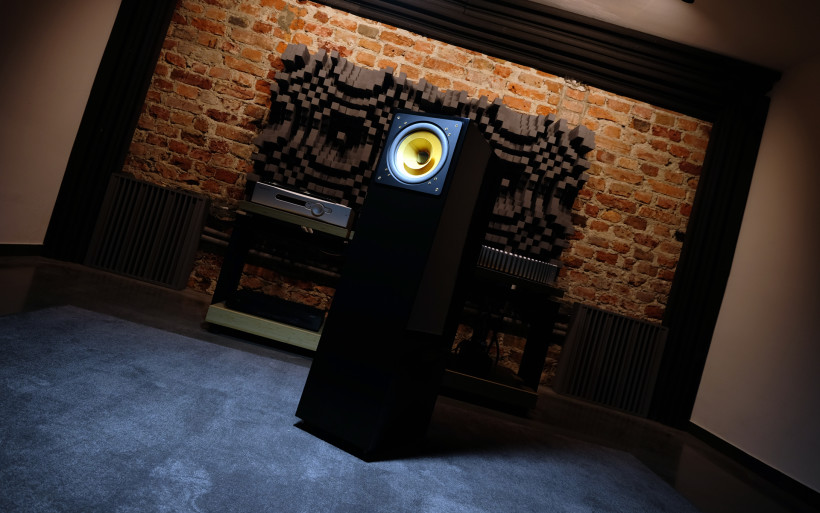 Cube Audio is yet another Polish manufacture. The core crew are two people: Grzegorz Rulka and Marek Kostrzyński. The former is the Poznan University of Technology (PUT) graduate, physics is his thing and so are full-range transducers. The latter gent is a passionate who over the years developed dozens of speakers for local Pylon Audio company, which is probably the most successful Polish one currently. When asked about the full-range path, Grzegorz doesn’t hide that the point source concept is an inspiration for the company, even though this topology is nothing new and groundbreaking all by itself. He’s been listening to music via such transducers exclusively for years, whereas Marek always had some objections about them. Yin and Yang then? It looks that way. In any case, after years of tinkering with multi-ways, the idea was born to design and build a proprietary full-range driver from ground up, yet free from issues these usually have. The goal was to limit the range and irregularities of mid FR. The full-range idea might not be innovative, but it all comes down to unique execution; one’s own solutions to combat against usual downsides of such transducers efficiently. Point being, there’s a lot of room to maneuver and stand out of the crowd if the job’s done well.
Cube Audio is yet another Polish manufacture. The core crew are two people: Grzegorz Rulka and Marek Kostrzyński. The former is the Poznan University of Technology (PUT) graduate, physics is his thing and so are full-range transducers. The latter gent is a passionate who over the years developed dozens of speakers for local Pylon Audio company, which is probably the most successful Polish one currently. When asked about the full-range path, Grzegorz doesn’t hide that the point source concept is an inspiration for the company, even though this topology is nothing new and groundbreaking all by itself. He’s been listening to music via such transducers exclusively for years, whereas Marek always had some objections about them. Yin and Yang then? It looks that way. In any case, after years of tinkering with multi-ways, the idea was born to design and build a proprietary full-range driver from ground up, yet free from issues these usually have. The goal was to limit the range and irregularities of mid FR. The full-range idea might not be innovative, but it all comes down to unique execution; one’s own solutions to combat against usual downsides of such transducers efficiently. Point being, there’s a lot of room to maneuver and stand out of the crowd if the job’s done well.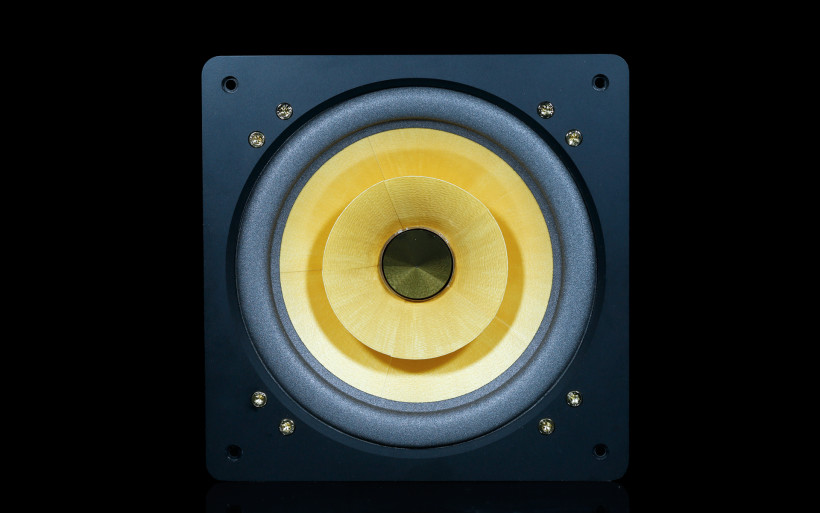 Marek’s first design based on one full-ranger married with a dipole 15″ woofer – Sensus – was showcased eight years ago at the AVS event and back then Grzegorz did all the audience talk. Both men regret that this product wasn’t developed further. In any case, a bit earlier was the unofficial Cube Audio start, now let’s fast forward six years. During the same show, both individuals got their first proprietary full-range driver ready. Though in the beta stage, it was operational nonetheless. Different magnet motor and membrane were on duty in comparison to current Cube Audio goods and there was the issue with keeping all parameters in check. It turned out that paper used to manufacture cones was the culprit. During the Audio Video Show in 2016, the refined version of the very same transducer was showcased and at that time it was in 90% complete. Cosmetic changes to magnet system happened since then, but paper along with its geometry and coating were completely revamped. The final result was achieved in early 2017 and this date both guys consider as the official Cube Audio operation launch.
Marek’s first design based on one full-ranger married with a dipole 15″ woofer – Sensus – was showcased eight years ago at the AVS event and back then Grzegorz did all the audience talk. Both men regret that this product wasn’t developed further. In any case, a bit earlier was the unofficial Cube Audio start, now let’s fast forward six years. During the same show, both individuals got their first proprietary full-range driver ready. Though in the beta stage, it was operational nonetheless. Different magnet motor and membrane were on duty in comparison to current Cube Audio goods and there was the issue with keeping all parameters in check. It turned out that paper used to manufacture cones was the culprit. During the Audio Video Show in 2016, the refined version of the very same transducer was showcased and at that time it was in 90% complete. Cosmetic changes to magnet system happened since then, but paper along with its geometry and coating were completely revamped. The final result was achieved in early 2017 and this date both guys consider as the official Cube Audio operation launch. These days Cube Audio is four men strong and their recently established proper HQ is equipped with a number of tools crucial during the development process. T/S parameters, frequency response, suspension docility and magnetic force are measured in there. Semi-parts are executed via subcontractors, membranes and coils are also in-house made from scratch and the final assembly and QC are conducted at the Cube Audio facility as well. At this time, the Polish manufacture is focused on sales, yet I’ve been told that in upcoming months we’ll see new 10″ full-range driver and field coils all across the board are next in the pipeline.
These days Cube Audio is four men strong and their recently established proper HQ is equipped with a number of tools crucial during the development process. T/S parameters, frequency response, suspension docility and magnetic force are measured in there. Semi-parts are executed via subcontractors, membranes and coils are also in-house made from scratch and the final assembly and QC are conducted at the Cube Audio facility as well. At this time, the Polish manufacture is focused on sales, yet I’ve been told that in upcoming months we’ll see new 10″ full-range driver and field coils all across the board are next in the pipeline. When asked about Cube Audio’s daily setup, Grzegorz informed me that they roll with an affordable class D amp married with an internal sound card of their stationary PC. That’s their starting point and if an early outcome is promising, they move to a number of friends’ places equipped with various setups. What’s important here is that they don’t trust their ears only and don’t care what an orthodox audiophile might think of their workbench. Cube Audio’s R&D department plays with what’s nearby and happy customers/journos do the rest. I also asked about their client base in general. The initial thought was that Grzegorz and Marek had to have a particular enthusiast type in mind before going formal with products as niche as full-rangers. Here’s yet another surprise, the team hasn’t figured this out yet. For now both gents are focused on properly yet steadily introducing their work and moving from there. Fair enough.
When asked about Cube Audio’s daily setup, Grzegorz informed me that they roll with an affordable class D amp married with an internal sound card of their stationary PC. That’s their starting point and if an early outcome is promising, they move to a number of friends’ places equipped with various setups. What’s important here is that they don’t trust their ears only and don’t care what an orthodox audiophile might think of their workbench. Cube Audio’s R&D department plays with what’s nearby and happy customers/journos do the rest. I also asked about their client base in general. The initial thought was that Grzegorz and Marek had to have a particular enthusiast type in mind before going formal with products as niche as full-rangers. Here’s yet another surprise, the team hasn’t figured this out yet. For now both gents are focused on properly yet steadily introducing their work and moving from there. Fair enough.
Build
The Cube Audio offer is quite compact. Three floorstanders, each loaded with a different driver, are all there is for now. Cube Audio Bliss A and Bliss C cost €4’990/pr and €5’990/pr respectively. The former model was reviewed already by Srajan, please take a look here. The newcomer – Magus – is pricier, €7’990/pr is the ask. That’s still two grand less in comparison to Voxativ’s Zeth model, which would most likely need additional sub. Available enclosure finishes covered by these sums are black and white options, both in gloss. Though if one wishes to, the whole RAL palette is available and so are various veneers, yet these are to be discussed individually and as such are of course more expensive. And if one is into DIY, standalone Cube Audio transducers can be purchased as well. The prices are €780/pr, €1’580/pr, and €2’980/pr for Fa8, Fc8 and F8 Magus respectively.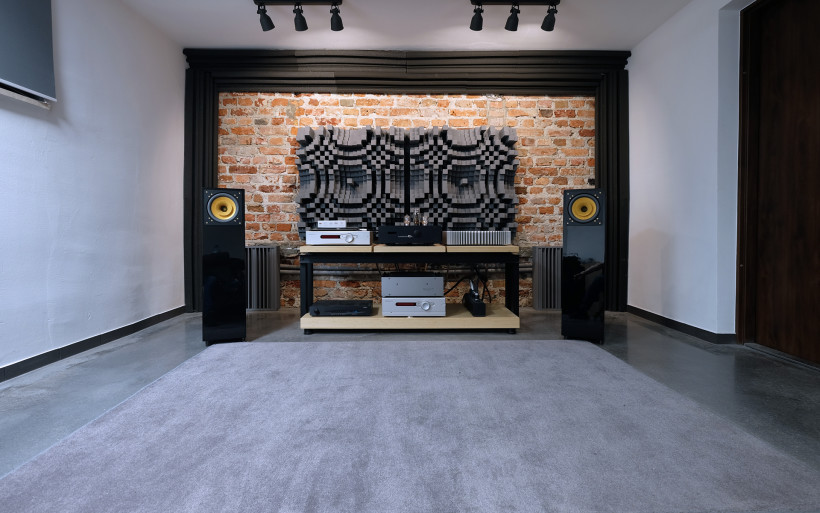 Let’s focus now solely on the Magus case. This product is the tapered quarter-wave transmission line affair loaded with one F8 Magus transducer per cabinet and… that’s it. Those unfamiliar with such designs should know that there’s nothing else going on in there. One single driver connects to speaker terminals directly, there’s no need to have any kind of x-over along the road, not even a very simple one. This is possible only when one driver covers all frequency range, that’s the principle of full-rangers and this subject I’ve already covered quite extensively here (Voxativ Zeth) and here (RDacoustic Evolution). At the same time it’s safe to say that topology of these two and F8 Magus is the most simplistic and the purest one there is in audio as far as loudspeakers go. One might ask why to go this road instead of something more common and presumably easier to pull off, but to listen to full-range floorstanders is to understand. They do sound very unique and a number of keen followers is the outcome. After hearing a product of this sort, many individuals simply fall in love with it and Grzegorz Rulka is one such example. A believer for life and for a good reason.
Let’s focus now solely on the Magus case. This product is the tapered quarter-wave transmission line affair loaded with one F8 Magus transducer per cabinet and… that’s it. Those unfamiliar with such designs should know that there’s nothing else going on in there. One single driver connects to speaker terminals directly, there’s no need to have any kind of x-over along the road, not even a very simple one. This is possible only when one driver covers all frequency range, that’s the principle of full-rangers and this subject I’ve already covered quite extensively here (Voxativ Zeth) and here (RDacoustic Evolution). At the same time it’s safe to say that topology of these two and F8 Magus is the most simplistic and the purest one there is in audio as far as loudspeakers go. One might ask why to go this road instead of something more common and presumably easier to pull off, but to listen to full-range floorstanders is to understand. They do sound very unique and a number of keen followers is the outcome. After hearing a product of this sort, many individuals simply fall in love with it and Grzegorz Rulka is one such example. A believer for life and for a good reason.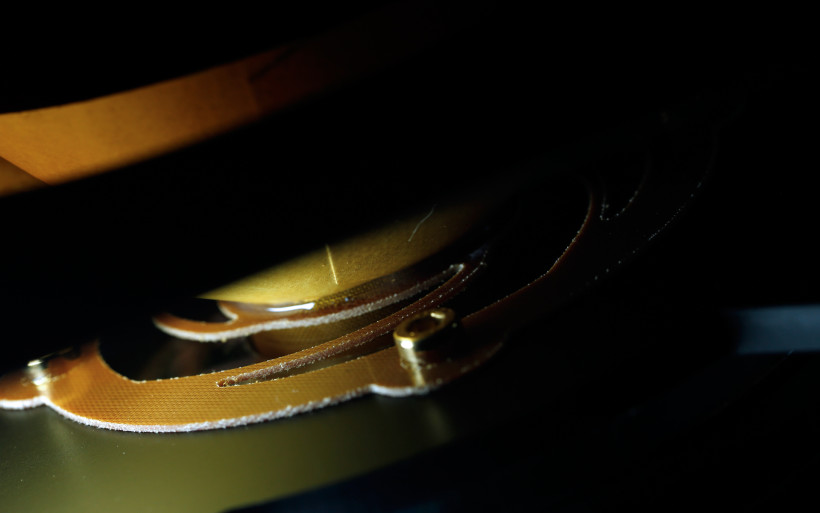 It might seem simple to develop such a driver, yet it isn’t. They say that the most basic labyrinths are the toughest ones to escape from and in the full-range game this saying is very valid. The Cube Audio team rolls with their own drivers. Yes, they don’t purchase and adjust options already available on the market to their own needs but build their own transducers from scratch. That’s a difficult, time consuming task and at the same time an approach to behold. There’s no place for cutting corners here. Before arriving with something decent to work with, Grzegorz and Marek did about 200 prototypes and this took two R&D years out of their lives without a single dime of the Cube Audio income. I was told that 80% of performance was done very quickly yet remaining rest was a true fight; with materials, parameters and final performance. In any case, to go this road is admirable in my book as it’s probably the most difficult one out there as far as sheer transducers go. That’s what happens when a company’s accountant is also a passionate above all else. And an engineer on top of that, this helps too 😉
It might seem simple to develop such a driver, yet it isn’t. They say that the most basic labyrinths are the toughest ones to escape from and in the full-range game this saying is very valid. The Cube Audio team rolls with their own drivers. Yes, they don’t purchase and adjust options already available on the market to their own needs but build their own transducers from scratch. That’s a difficult, time consuming task and at the same time an approach to behold. There’s no place for cutting corners here. Before arriving with something decent to work with, Grzegorz and Marek did about 200 prototypes and this took two R&D years out of their lives without a single dime of the Cube Audio income. I was told that 80% of performance was done very quickly yet remaining rest was a true fight; with materials, parameters and final performance. In any case, to go this road is admirable in my book as it’s probably the most difficult one out there as far as sheer transducers go. That’s what happens when a company’s accountant is also a passionate above all else. And an engineer on top of that, this helps too 😉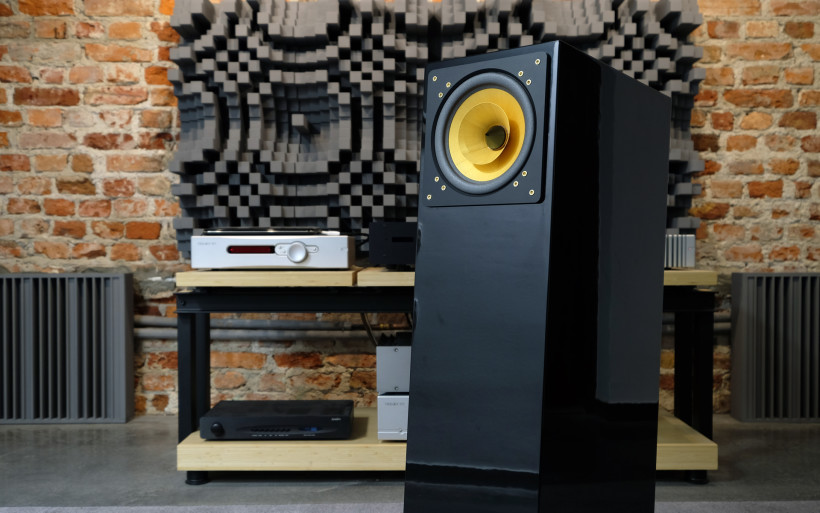 F8 Magus driver is 22,2 cm wide and high, 14 cm deep and eight kilograms heavy. Helluva transducer, yet not of crazy sensitivity, 94 dB is the number and its nominal impedance is six ohms, though Magus floorstanders are rated at two ohms higher. Along with generously big enclosure (100l brutto is the exact number), this was the main strategic decision the Cube Audio team went with. At the same time it explains why their F8 Magus roars pleasantly downstairs without any effort and is considered as a true full-range unit. Grzegorz asked about this only smiled and confirmed that as linear bandwidth as possible was their main goal right from the get-go, not sensitivity.
F8 Magus driver is 22,2 cm wide and high, 14 cm deep and eight kilograms heavy. Helluva transducer, yet not of crazy sensitivity, 94 dB is the number and its nominal impedance is six ohms, though Magus floorstanders are rated at two ohms higher. Along with generously big enclosure (100l brutto is the exact number), this was the main strategic decision the Cube Audio team went with. At the same time it explains why their F8 Magus roars pleasantly downstairs without any effort and is considered as a true full-range unit. Grzegorz asked about this only smiled and confirmed that as linear bandwidth as possible was their main goal right from the get-go, not sensitivity.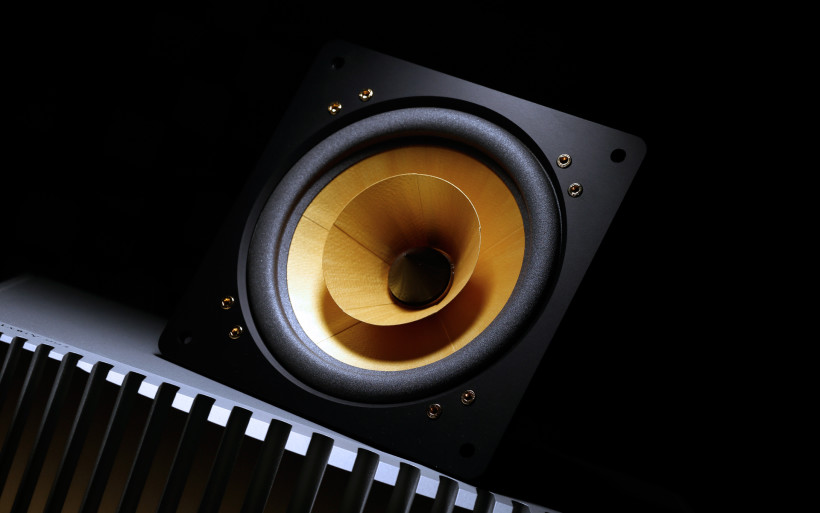 The Cube Audio crew started with the magnetic motor design. In case of this operation’s 8″ drivers, it’s powered by both ferrite and neodymium magnets cut via CNC lathes to maintain very sharp 0,01 tolerances. The hybrid magnet geometry of the pole nets 2,0 Tesla field strength. Because of 9 mm magnetic gap height, completely underhung voice coil doesn’t leave it and raw power, linearity and low distortions are the outcome. Magnetic motor is enhanced by copper&aluminium Faraday Ring system, which leads to further improvements in eddy currents elimination and voice coil inductance, which translates to higher cut-off frequency and distortions lowered.
The Cube Audio crew started with the magnetic motor design. In case of this operation’s 8″ drivers, it’s powered by both ferrite and neodymium magnets cut via CNC lathes to maintain very sharp 0,01 tolerances. The hybrid magnet geometry of the pole nets 2,0 Tesla field strength. Because of 9 mm magnetic gap height, completely underhung voice coil doesn’t leave it and raw power, linearity and low distortions are the outcome. Magnetic motor is enhanced by copper&aluminium Faraday Ring system, which leads to further improvements in eddy currents elimination and voice coil inductance, which translates to higher cut-off frequency and distortions lowered.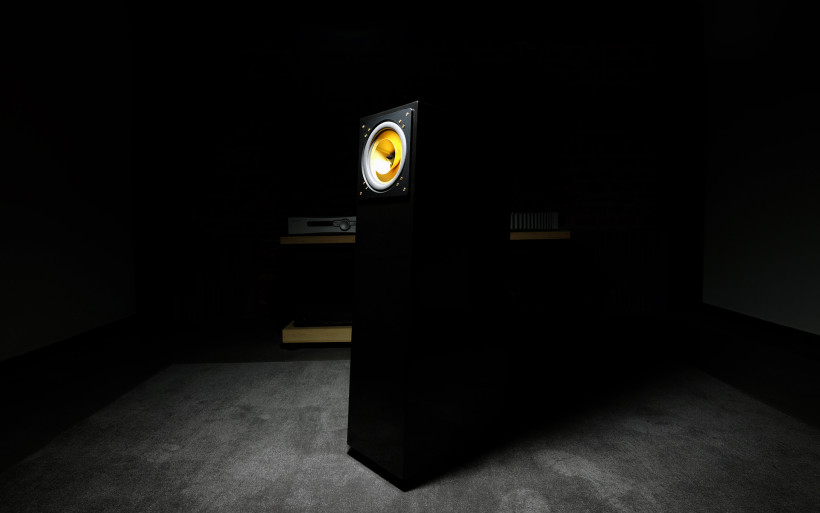 The next stop is a lower suspension commonly known as ‘a spider’. After tests which involved a number of pre-made solutions, the decision was made to get back to the drawing board. The main goal was to develop a spider of as little energy dissipation as possible. Less damping and more transferring was the case and – as Grzegorz informed me – the material they use is in 100% linear within the maximum cone excursion. By virtually not consuming energy, it acts like a spring and looks very unusual as visually it somewhat resembles one of fidget spinners so popular these days. In order for this element to work as intended, it has to be manufactured as precisely as possible and here CNC machine is also involved. In order to measure the actual compliance (the amount of excursion under known force) of a given suspension, a special device was designed and in-house built. Cones used in F8 Magus are made out of paper. After many tests, the conclusion was that cellulose is the best material for the job (Mr Voxativ knows this for years already) and lightweight organic resin solution was developed to keep the moisture away. There’s no other way around it, paper is susceptible to this effect and high FR becomes worse and worse over time if a membrane isn’t cured.
The next stop is a lower suspension commonly known as ‘a spider’. After tests which involved a number of pre-made solutions, the decision was made to get back to the drawing board. The main goal was to develop a spider of as little energy dissipation as possible. Less damping and more transferring was the case and – as Grzegorz informed me – the material they use is in 100% linear within the maximum cone excursion. By virtually not consuming energy, it acts like a spring and looks very unusual as visually it somewhat resembles one of fidget spinners so popular these days. In order for this element to work as intended, it has to be manufactured as precisely as possible and here CNC machine is also involved. In order to measure the actual compliance (the amount of excursion under known force) of a given suspension, a special device was designed and in-house built. Cones used in F8 Magus are made out of paper. After many tests, the conclusion was that cellulose is the best material for the job (Mr Voxativ knows this for years already) and lightweight organic resin solution was developed to keep the moisture away. There’s no other way around it, paper is susceptible to this effect and high FR becomes worse and worse over time if a membrane isn’t cured.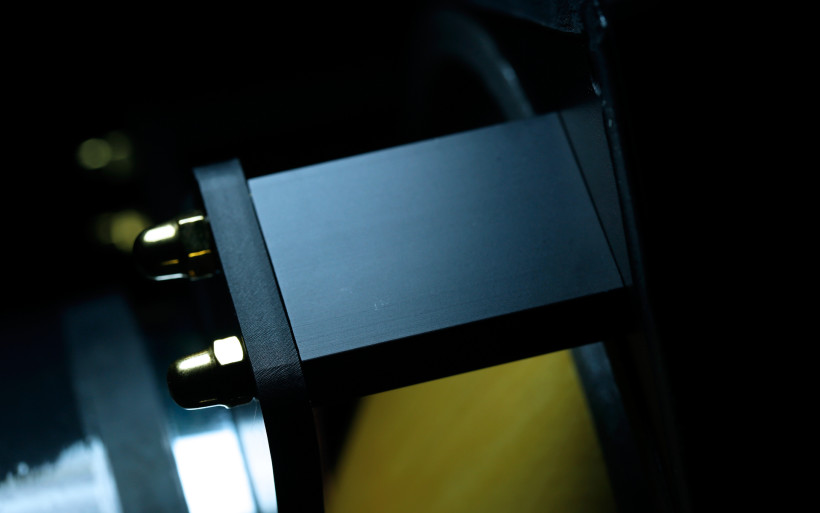 The Magus enclosure is compact. Dimensions of (W x H x D) 25 x 100 x 40 cm indicate that the product is of quite domestic size and 29 kilograms mass per speaker make it perfectly manageable by a single man. The version delivered to me looks very vanilla. One transducer per cabinet is mounted up high on the front, the mouth is to be found on the bottom and a pair of quite common speaker terminals are mounted on an aluminium plate located in the lower rear area. All this is very simple indeed, yet visually non-obtrusive and universal. Each box is slightly tilted as two of its frontal spikes are higher than a pair of rubber washers in the back. Fit’n’finish is of quality, yet nothing spectacular/flashy aesthetically. It’s very Scandinavian alike I’d say. If that’s not pleasing enough for you, please look away and point your steps towards Sonus faber and the lot. Oh shit, wait, they aren’t in the full-range game. Right, case closed then.
The Magus enclosure is compact. Dimensions of (W x H x D) 25 x 100 x 40 cm indicate that the product is of quite domestic size and 29 kilograms mass per speaker make it perfectly manageable by a single man. The version delivered to me looks very vanilla. One transducer per cabinet is mounted up high on the front, the mouth is to be found on the bottom and a pair of quite common speaker terminals are mounted on an aluminium plate located in the lower rear area. All this is very simple indeed, yet visually non-obtrusive and universal. Each box is slightly tilted as two of its frontal spikes are higher than a pair of rubber washers in the back. Fit’n’finish is of quality, yet nothing spectacular/flashy aesthetically. It’s very Scandinavian alike I’d say. If that’s not pleasing enough for you, please look away and point your steps towards Sonus faber and the lot. Oh shit, wait, they aren’t in the full-range game. Right, case closed then.
Sound
In order to review the Cube Audio Magus, PureAudioProject Trio10 Voxativ open-baffle floorstanders were used. Trilogy 925 integrated, Trilogy 993 + 903 and FirstWatt F7 were on duty as well. As per usual, LampizatOr Golden Gate (Psvane WE-101D + KR Audio 5U4G Ltd. Ed.) handled the d/a conversion task, whereas Asus UX305LA was responsible for files storage and OS control. Also, FirstWatt F7 was matched with Trilogy 903 preamplifier. Here’s the story.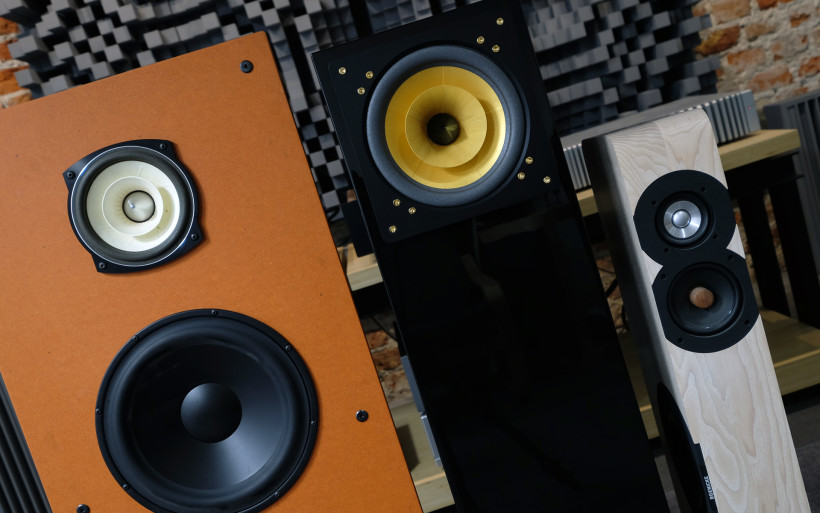 Alright, let’s address the elephant in the room, Voxativ Zeth that is. It was reviewed a good while ago, yet sits in my memory rather well because of a number of perfectly valid reasons. This €9’900 floorstander with one full-range driver per cabinet on-board turned out to be the toughest product I’ve had a pleasure to review thus far. Several weeks it took me to find an amplifier which would actually work with it as expected. Eventually I was able to get these German cogs moving, Polish Amare Musica Entropy Diamond did the job nicely and Egg-Shell Prestige 9WST Mk2 as well, yet everything prior these decks didn’t, not even my 20WPC Class A FirstWatt F7. When improperly amplified, Zeth speakers sound thin, lit-up, piercing and their low-end is simply gone. In the end I’ve found it to be a very well-seasoned and enjoyable performer, but the struggle it took to discover this side of Zeth is still memorable. The takeaway is that it’s very nicely sounding, luxurious and expensive product. But one really has to already have a proper amplifier, otherwise a scenario similar to my early experience is highly likely. And still, presumably many people would like to have this product complimented via a separate sub. This is worth remembering at this point as Cube Audio Magus is a completely different beast in this regard.
Alright, let’s address the elephant in the room, Voxativ Zeth that is. It was reviewed a good while ago, yet sits in my memory rather well because of a number of perfectly valid reasons. This €9’900 floorstander with one full-range driver per cabinet on-board turned out to be the toughest product I’ve had a pleasure to review thus far. Several weeks it took me to find an amplifier which would actually work with it as expected. Eventually I was able to get these German cogs moving, Polish Amare Musica Entropy Diamond did the job nicely and Egg-Shell Prestige 9WST Mk2 as well, yet everything prior these decks didn’t, not even my 20WPC Class A FirstWatt F7. When improperly amplified, Zeth speakers sound thin, lit-up, piercing and their low-end is simply gone. In the end I’ve found it to be a very well-seasoned and enjoyable performer, but the struggle it took to discover this side of Zeth is still memorable. The takeaway is that it’s very nicely sounding, luxurious and expensive product. But one really has to already have a proper amplifier, otherwise a scenario similar to my early experience is highly likely. And still, presumably many people would like to have this product complimented via a separate sub. This is worth remembering at this point as Cube Audio Magus is a completely different beast in this regard.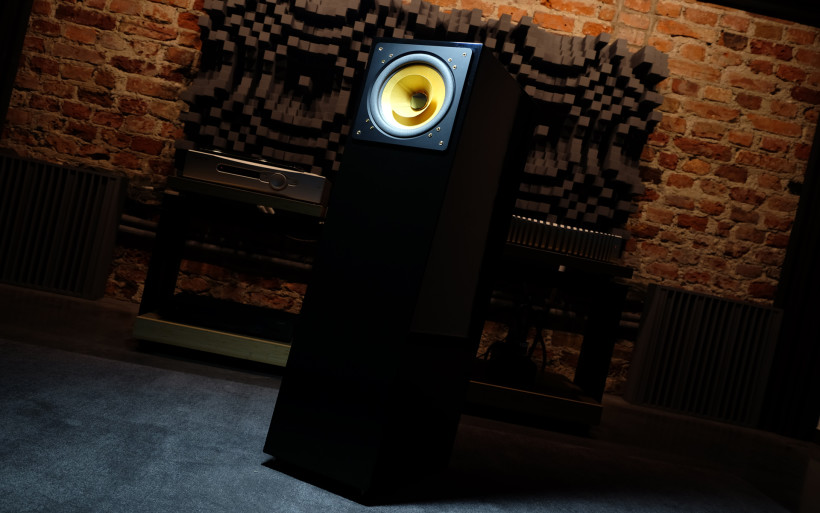 The Magus delivered to yours truly turned out to be a very surprising performer. Very. Past the Zeth experience, the initial assumption was that this time around the struggle is imminent as well. The same breed of speakers indicated so. Early on, the question was not about the shortcomings’ presence, but their number and severity. To my great surprise, none occurred. Magus isn’t picky in terms of company or shy but easygoing and pleasantly substantial. The very first noticeable thing in its case is no bandwidth shortage. The Polish product handles music not only in quite big and bold fashion, but also coherently as hell. Full-range transducers are known for their ability to get the job done as far as this aspect and imaging go, yet Magus ups the ante by not only staying in check here but pushing things even further once party level listening is on. To simplify, the louder it gets, the more substantial the sound is while maintaining cleanliness, all spatial features and informational value.
The Magus delivered to yours truly turned out to be a very surprising performer. Very. Past the Zeth experience, the initial assumption was that this time around the struggle is imminent as well. The same breed of speakers indicated so. Early on, the question was not about the shortcomings’ presence, but their number and severity. To my great surprise, none occurred. Magus isn’t picky in terms of company or shy but easygoing and pleasantly substantial. The very first noticeable thing in its case is no bandwidth shortage. The Polish product handles music not only in quite big and bold fashion, but also coherently as hell. Full-range transducers are known for their ability to get the job done as far as this aspect and imaging go, yet Magus ups the ante by not only staying in check here but pushing things even further once party level listening is on. To simplify, the louder it gets, the more substantial the sound is while maintaining cleanliness, all spatial features and informational value.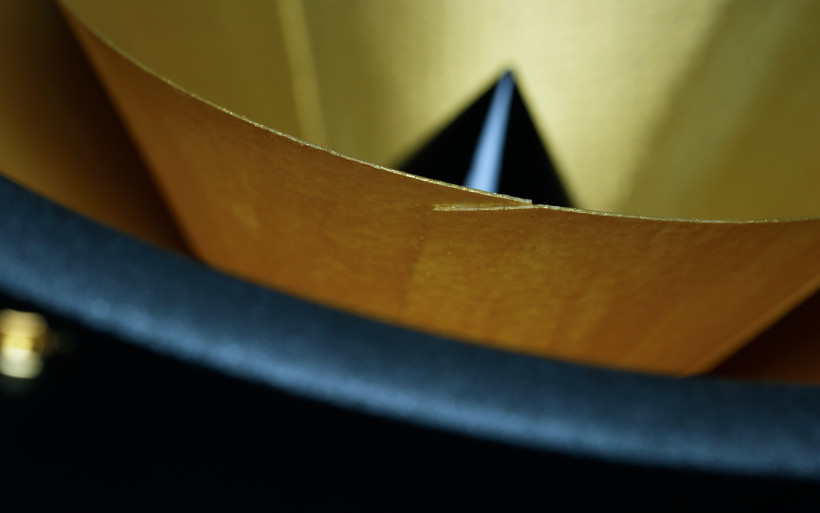 Let me explain what the ‘substantial’ word means in the Magus context. The so-called meat on the bones is present with these speakers all across the board. During long auditions, and there were many of them I assure you, the notion of music overly thin or thick, hence in need of alterations, not even once was present. As far as density and saturation go, the performance was a spot-on each and every time. Magus turned out to be well-seasoned in this regard, not only because of the usual full-range related virtues but admirable downstairs reach, frequencies rather felt than heard and served not in the boomy fashion but properly tightly on top of that. When tension, crack and shove were needed, all this exactly was given. Moving on, upper bass realm wasn’t emphasized which led to no veil on the midrange, these two were seamlessly sewn altogether. As a whole, Low FR was generously beefy, very finely textured and agile. No hollowness occurred in there at all. In terms of sheer speed, Magus doesn’t play in the F1 league, it’s too saturated to be perceived as such a vehicle. I’d say it’s more of a NASCAR performer; loaded with lots of HP under the hood, therefore snappy and effortless when needed, but properly muscular and pleasant to watch on the track. To translate this into the audiophile lingo, Polish speakers cover every bass related field there is in most situations, at times in surprisingly good fashion, but don’t emphasize this FR.
Let me explain what the ‘substantial’ word means in the Magus context. The so-called meat on the bones is present with these speakers all across the board. During long auditions, and there were many of them I assure you, the notion of music overly thin or thick, hence in need of alterations, not even once was present. As far as density and saturation go, the performance was a spot-on each and every time. Magus turned out to be well-seasoned in this regard, not only because of the usual full-range related virtues but admirable downstairs reach, frequencies rather felt than heard and served not in the boomy fashion but properly tightly on top of that. When tension, crack and shove were needed, all this exactly was given. Moving on, upper bass realm wasn’t emphasized which led to no veil on the midrange, these two were seamlessly sewn altogether. As a whole, Low FR was generously beefy, very finely textured and agile. No hollowness occurred in there at all. In terms of sheer speed, Magus doesn’t play in the F1 league, it’s too saturated to be perceived as such a vehicle. I’d say it’s more of a NASCAR performer; loaded with lots of HP under the hood, therefore snappy and effortless when needed, but properly muscular and pleasant to watch on the track. To translate this into the audiophile lingo, Polish speakers cover every bass related field there is in most situations, at times in surprisingly good fashion, but don’t emphasize this FR.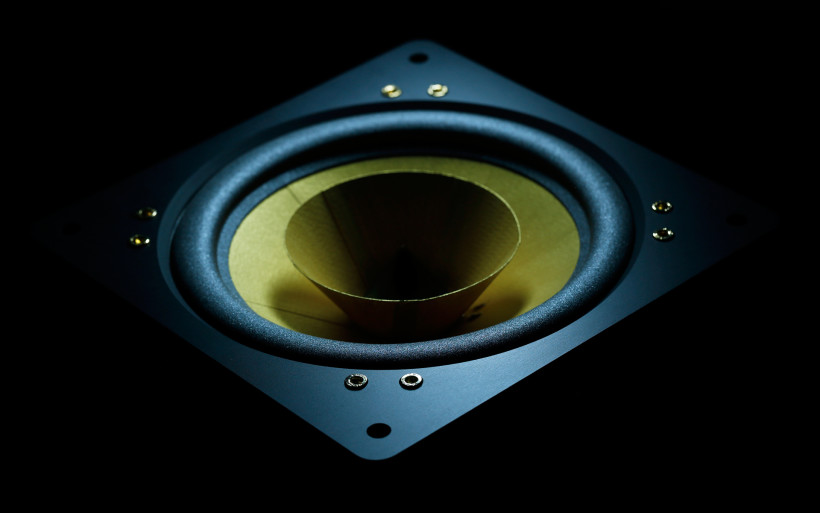 The most obvious difference between Magus and Zeth is bass. Even with the most synergistic companion I was able to muster, the latter left me with an impression of the sound built around its midrange. The basement region complimented everything up above, hence fulfilled the additive duty. Magus is much bolder in this regard as its low FR doesn’t compliment anything but acts as a full-fledged member of the whole audible realm instead. That’s the main difference between the two and at the same time the very reason why the Polish product is more direct and ballsier one. Yes, Zeth was auditioned almost a year ago and I’m not capable of saying which floorstander has an edge as far as i.e. instruments’ reproduction goes. That’s undoable without having both of ’em compared side by side, pure guesswork. But their bass approach is very different indeed and after 11 months without Zeth nearby, still crystal clear to me. I strongly believe that Magus can hold its ground against regular two or three-ways with ease in this regard, it’s this good.
The most obvious difference between Magus and Zeth is bass. Even with the most synergistic companion I was able to muster, the latter left me with an impression of the sound built around its midrange. The basement region complimented everything up above, hence fulfilled the additive duty. Magus is much bolder in this regard as its low FR doesn’t compliment anything but acts as a full-fledged member of the whole audible realm instead. That’s the main difference between the two and at the same time the very reason why the Polish product is more direct and ballsier one. Yes, Zeth was auditioned almost a year ago and I’m not capable of saying which floorstander has an edge as far as i.e. instruments’ reproduction goes. That’s undoable without having both of ’em compared side by side, pure guesswork. But their bass approach is very different indeed and after 11 months without Zeth nearby, still crystal clear to me. I strongly believe that Magus can hold its ground against regular two or three-ways with ease in this regard, it’s this good. In spite of respectable bass performance, Magus doesn’t hide with its roots at all. The main full-range qualities are on the pedestal. That’s the common denominator of this product and Voxativ Zeth. The Polish product sounds very lively, tangible and smooth. Its performance is easygoing and completely tension-free. Heavy focus on the musical tissue and stress-free attitude are there, which leads to joyful and effortless outcome of great quality. Magus doesn’t emphasize neither agility nor calmness, it sounds simply right and serves the music above all else via allowing a given track to command the show. When there’s the demand to have things served in snappy, direct and intense fashion, it’s done with no questions asked. But this can change in a heartbeat to much more romantic, atmospheric, ethereal and involving spectacle. Real instruments and vocals are bread and butter for full-range drivers and here Magus shines very brightly. But here’s the major twist – it can work with every type of music there is without a hint of a struggle. Yes, it goes rather without saying that the real thing (aka. Mari Boine, Melody Gardot, Johnny Cash, Eivør Pálsdóttir, Varttina, Colin Stetson, Julee Cruise), folk (Wardruna, Danheim) or minimalist shenanigans (The Acid) are the way to go. But at the same time I had a blast with Mike Oldfield, David Lynch (yup, Mr ‘Lost Highway’ also makes music), Monster Magnet, Muse or Einstürzende Eeubauten. Magus does it all and greatly developed low end of both quality and quantity certainly helps to pull this off.
In spite of respectable bass performance, Magus doesn’t hide with its roots at all. The main full-range qualities are on the pedestal. That’s the common denominator of this product and Voxativ Zeth. The Polish product sounds very lively, tangible and smooth. Its performance is easygoing and completely tension-free. Heavy focus on the musical tissue and stress-free attitude are there, which leads to joyful and effortless outcome of great quality. Magus doesn’t emphasize neither agility nor calmness, it sounds simply right and serves the music above all else via allowing a given track to command the show. When there’s the demand to have things served in snappy, direct and intense fashion, it’s done with no questions asked. But this can change in a heartbeat to much more romantic, atmospheric, ethereal and involving spectacle. Real instruments and vocals are bread and butter for full-range drivers and here Magus shines very brightly. But here’s the major twist – it can work with every type of music there is without a hint of a struggle. Yes, it goes rather without saying that the real thing (aka. Mari Boine, Melody Gardot, Johnny Cash, Eivør Pálsdóttir, Varttina, Colin Stetson, Julee Cruise), folk (Wardruna, Danheim) or minimalist shenanigans (The Acid) are the way to go. But at the same time I had a blast with Mike Oldfield, David Lynch (yup, Mr ‘Lost Highway’ also makes music), Monster Magnet, Muse or Einstürzende Eeubauten. Magus does it all and greatly developed low end of both quality and quantity certainly helps to pull this off.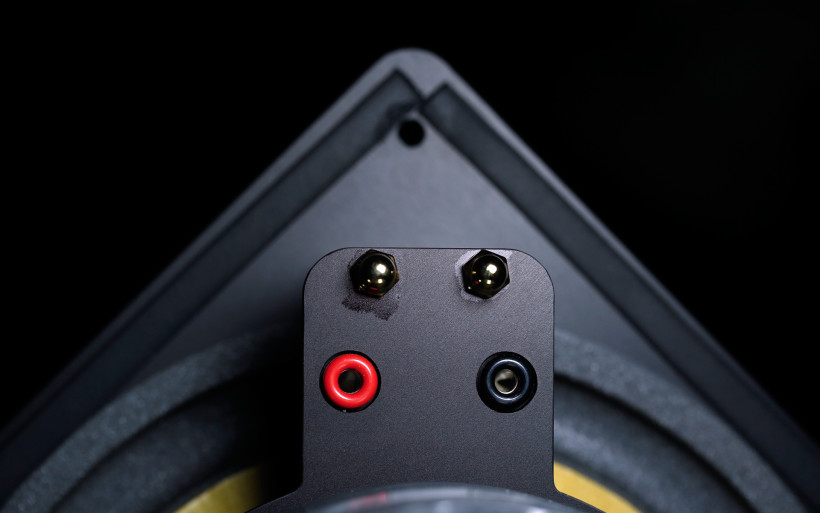 Confessions above indicate that Magus isn’t shy at all and the soundstage it creates is yet another aspect to confirm this. The picture in front of a listener is very generous all across the board; wide, deep and tall. It occurred to me that these speakers would fare well in rooms bigger than my own 24 sq. meters listening place with ease. How much bigger? I can’t say exactly. The Cube Audio team polishes their 10″ transducer which should handle spaces twice as generous. Still, based on how Magus behaved in my cave, my rough guess is that it’d handle itself nicely in places not much smaller. Moving on, this product sketches virtual sound sources meticulously and effortlessly, but at the same time shows ’em in very lively way, namely as properly thick and lifelike beings. Each is finely separated, but the important part here is that virtual space shown acts like one coherent, moving, breathing, plainly big and present organism. Unless a given track demands it, neither hollowness nor notion of drivers being pushed too much are there and that’s very impressive. When all this is combined with everything I’ve discussed up above, well, I can only say that Magus is a stunning performer and nothing less. But that’s not the whole story, not yet.
Confessions above indicate that Magus isn’t shy at all and the soundstage it creates is yet another aspect to confirm this. The picture in front of a listener is very generous all across the board; wide, deep and tall. It occurred to me that these speakers would fare well in rooms bigger than my own 24 sq. meters listening place with ease. How much bigger? I can’t say exactly. The Cube Audio team polishes their 10″ transducer which should handle spaces twice as generous. Still, based on how Magus behaved in my cave, my rough guess is that it’d handle itself nicely in places not much smaller. Moving on, this product sketches virtual sound sources meticulously and effortlessly, but at the same time shows ’em in very lively way, namely as properly thick and lifelike beings. Each is finely separated, but the important part here is that virtual space shown acts like one coherent, moving, breathing, plainly big and present organism. Unless a given track demands it, neither hollowness nor notion of drivers being pushed too much are there and that’s very impressive. When all this is combined with everything I’ve discussed up above, well, I can only say that Magus is a stunning performer and nothing less. But that’s not the whole story, not yet. Polish floorstanders are very easygoing in comparison to Voxativ Zeth. They’ll sing with literally everything out there and as such are even less demanding than i.e. my reference W8 Swiss champs. Heck, come to think of it, I’m certain that Magus would even go with Class D and – as I’ve explained up above – such product is actually the daily driver for people behind these Polish boxes. Point being, muscle tissue gain is nowhere near as needed with Magus as it is with Zeth. Operation mode of a given amplifier is still important, but not crucial in the Polish case. To paint somewhat broader picture, each deck used to make this writing complete (Trilogy 993 and FirstWatt F7 fronted by 903 preamplifier, Trilogy 925) worked like a charm, whereas with Zeth neither would. I’ve been there, I’ve done that, case closed. This marvelous feature alone turns Magus into a very friendly product for people who’d like to know what the full-range game is all about yet are hesitant to play. There’s no need, this one has got you covered and with a bang. In this regard in particular, the difference between Polish and German speakers is simply staggering and – after getting familiar with Zeth months back – shortly past Magus arrival I was in doubt that even remotely possible. Night and day difference? In this regard in particular nothing but. Go figure.
Polish floorstanders are very easygoing in comparison to Voxativ Zeth. They’ll sing with literally everything out there and as such are even less demanding than i.e. my reference W8 Swiss champs. Heck, come to think of it, I’m certain that Magus would even go with Class D and – as I’ve explained up above – such product is actually the daily driver for people behind these Polish boxes. Point being, muscle tissue gain is nowhere near as needed with Magus as it is with Zeth. Operation mode of a given amplifier is still important, but not crucial in the Polish case. To paint somewhat broader picture, each deck used to make this writing complete (Trilogy 993 and FirstWatt F7 fronted by 903 preamplifier, Trilogy 925) worked like a charm, whereas with Zeth neither would. I’ve been there, I’ve done that, case closed. This marvelous feature alone turns Magus into a very friendly product for people who’d like to know what the full-range game is all about yet are hesitant to play. There’s no need, this one has got you covered and with a bang. In this regard in particular, the difference between Polish and German speakers is simply staggering and – after getting familiar with Zeth months back – shortly past Magus arrival I was in doubt that even remotely possible. Night and day difference? In this regard in particular nothing but. Go figure.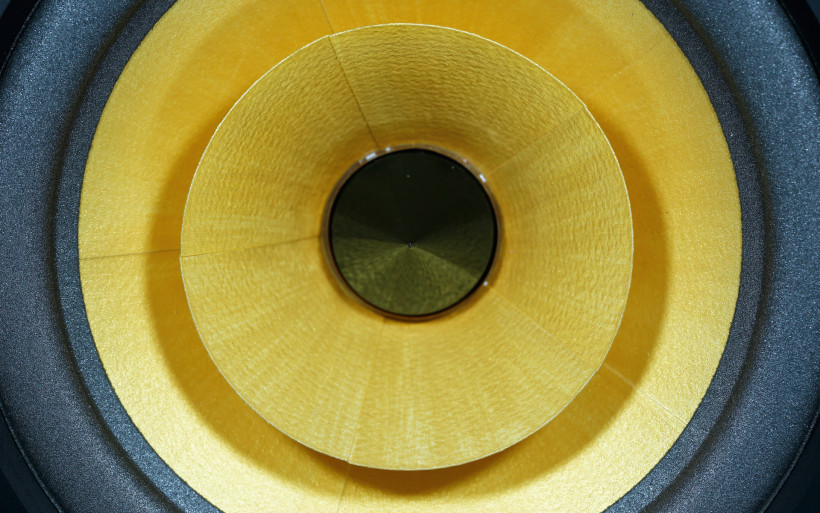 The amplifiers related matter needs to be explained even further. The most important thing to know is that in case of Magus, it was of no matter which deck was in use. My point here is that all three worked very well, each turned out to be valid and the only questions before any setup tinkering were these two: “In what mood am I today?”, “Which aspect I’d like to have emphasized?”. The sensation of not having to use lesser evil was liberating and quite comparable to eating the same favourite dish yet made by three different chefs. Each tasty, but in its own way. No bad choices whatsoever.
The amplifiers related matter needs to be explained even further. The most important thing to know is that in case of Magus, it was of no matter which deck was in use. My point here is that all three worked very well, each turned out to be valid and the only questions before any setup tinkering were these two: “In what mood am I today?”, “Which aspect I’d like to have emphasized?”. The sensation of not having to use lesser evil was liberating and quite comparable to eating the same favourite dish yet made by three different chefs. Each tasty, but in its own way. No bad choices whatsoever.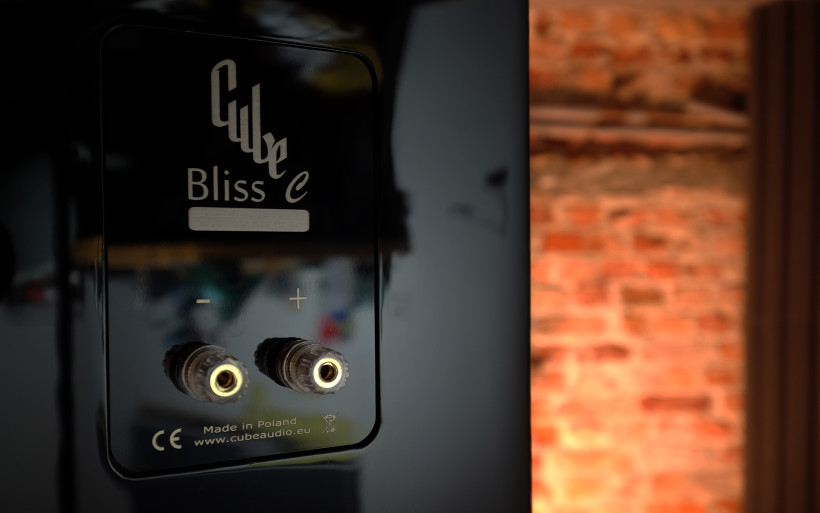 Trilogy 925 was the intimacy, presence and bass oomph provider. The sound with this integrated was smooth, dense and calm, with the very first row closely served. The 993 + 903 combo by the same manufacturer shifted the meta audibly. The outcome got leaner yet airier, hence became very open and with elevated articulation. But also more thunderous and immediate down below; less body was audible in upper bass whereas the basement became very present. In a nutshell, romanticism slightly faded yet additional agility injection happened instead. FirstWatt F7 was slightly wobbly downstairs, the rumble effect occurred yet the sound was full, enjoyable still, midrange focused and with slightly trimmed top end. FirstWatt F7 wasn’t able to single-out each layer as precisely as English decks. In this American case the meta yet again shifted to pleasure via additional density and elevated temperature.
Trilogy 925 was the intimacy, presence and bass oomph provider. The sound with this integrated was smooth, dense and calm, with the very first row closely served. The 993 + 903 combo by the same manufacturer shifted the meta audibly. The outcome got leaner yet airier, hence became very open and with elevated articulation. But also more thunderous and immediate down below; less body was audible in upper bass whereas the basement became very present. In a nutshell, romanticism slightly faded yet additional agility injection happened instead. FirstWatt F7 was slightly wobbly downstairs, the rumble effect occurred yet the sound was full, enjoyable still, midrange focused and with slightly trimmed top end. FirstWatt F7 wasn’t able to single-out each layer as precisely as English decks. In this American case the meta yet again shifted to pleasure via additional density and elevated temperature. The takeaway here is that no urge to tinker with the setup was on and that’s very unusual. When a promise of sound possibly better/different/more enjoyable after some swaps is on the table, alterations of the sort are conducted rather sooner than later in case of this scribe. Not with Magus and decks I had on hand though, no. All three machines were in rotation not because of subconscious urge somewhere deep inside my noggin to make the sound nicer, but as an effect of natural mood swings and/or finding enough strength to beat inner laziness, move from the Ikea Poäng chair and alter the outcome in the process. I remember that one time all three amps were on the on and off duty constantly throughout the day, whereas two moons later perfect happiness was achieved with just one in the chain for long hours. That’s how easygoing and generous Magus turned out to be and this feature alone is no less than damn impressive. Past the Zeth battle, to me at least. And lastly, I can’t say whether this Polish floorstander will sing with every company there is, but rest assured that with most out there it should.
The takeaway here is that no urge to tinker with the setup was on and that’s very unusual. When a promise of sound possibly better/different/more enjoyable after some swaps is on the table, alterations of the sort are conducted rather sooner than later in case of this scribe. Not with Magus and decks I had on hand though, no. All three machines were in rotation not because of subconscious urge somewhere deep inside my noggin to make the sound nicer, but as an effect of natural mood swings and/or finding enough strength to beat inner laziness, move from the Ikea Poäng chair and alter the outcome in the process. I remember that one time all three amps were on the on and off duty constantly throughout the day, whereas two moons later perfect happiness was achieved with just one in the chain for long hours. That’s how easygoing and generous Magus turned out to be and this feature alone is no less than damn impressive. Past the Zeth battle, to me at least. And lastly, I can’t say whether this Polish floorstander will sing with every company there is, but rest assured that with most out there it should.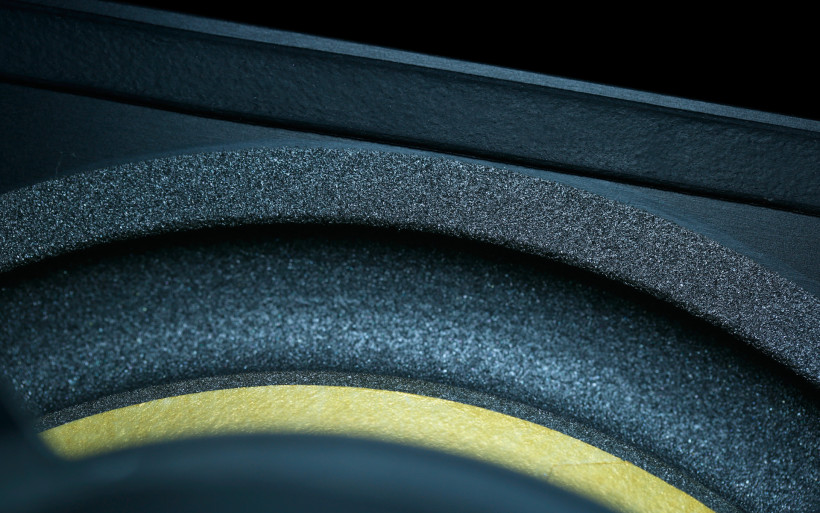 After knowing what Magus really is and how it interacts with a number of different amplifiers, it was high time to tackle the Trio10 Voxativ case. The fundamental difference between the two is in amplification needs. Polish champ we’ve already covered, whereas the Israeli OB affair needs powerful decks, hence it doesn’t work with FirstWatt F7 at all and Trilogy 925 is not quite optimal as practice showed me recently. The only viable solution among those I’ve had on hand turned out to be the Trilogy 993 + 903 combo. But damn good one it is with PureAudioProject’s speakers. It was heard in an instant that – as far as bass quantity goes – Trio10 Voxativ clearly is from another mother, which is hardly any surprise. Not only this product sported beefier upper LF range, but also more thunderous basement and this was not only heard but felt as well. The sheer crack was very intense with Israeli performer and so were my cave’s mods at times (of course that’s not this product’s fault, my inferior place is the one to blame), especially during loud listening. Point being, both models beg for it and feel perfectly comfortable when the 90 dB and upwards SPL aka. the party mode is on.
After knowing what Magus really is and how it interacts with a number of different amplifiers, it was high time to tackle the Trio10 Voxativ case. The fundamental difference between the two is in amplification needs. Polish champ we’ve already covered, whereas the Israeli OB affair needs powerful decks, hence it doesn’t work with FirstWatt F7 at all and Trilogy 925 is not quite optimal as practice showed me recently. The only viable solution among those I’ve had on hand turned out to be the Trilogy 993 + 903 combo. But damn good one it is with PureAudioProject’s speakers. It was heard in an instant that – as far as bass quantity goes – Trio10 Voxativ clearly is from another mother, which is hardly any surprise. Not only this product sported beefier upper LF range, but also more thunderous basement and this was not only heard but felt as well. The sheer crack was very intense with Israeli performer and so were my cave’s mods at times (of course that’s not this product’s fault, my inferior place is the one to blame), especially during loud listening. Point being, both models beg for it and feel perfectly comfortable when the 90 dB and upwards SPL aka. the party mode is on.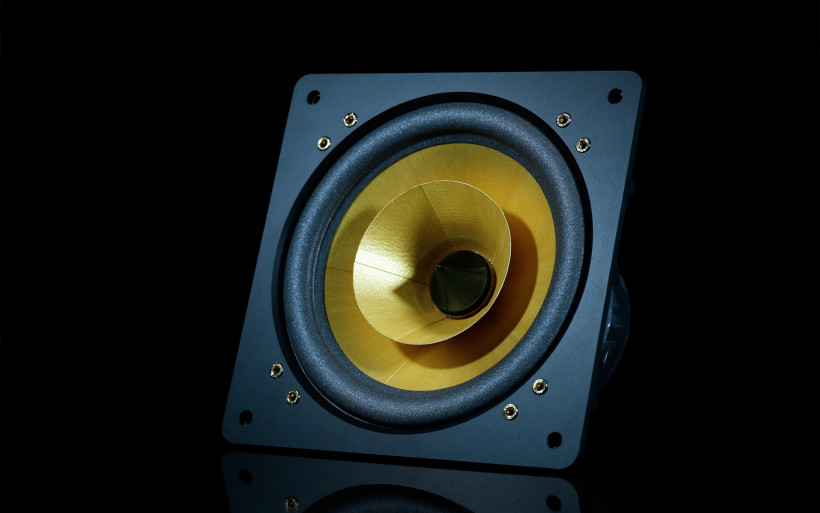 Having constantly on mind that a single driver per box does the job in the Polish case, its downstairs performance was respectable still. As far as details retrieval and accuracy go, the fight was inconclusive, both floorstanders turned out to be marvelous here, I could live happily with both and similar story is with imaging. The disappearing act was performed by each very efficiently too. The only noticeable difference was in the sheer image size. Trio10 Voxativ painted picture slightly lower, yet at the same time even more complex and served it in somewhat more romantic style. Slightly different flavours, yet both tasty, that’s what I’m sayin’.
Having constantly on mind that a single driver per box does the job in the Polish case, its downstairs performance was respectable still. As far as details retrieval and accuracy go, the fight was inconclusive, both floorstanders turned out to be marvelous here, I could live happily with both and similar story is with imaging. The disappearing act was performed by each very efficiently too. The only noticeable difference was in the sheer image size. Trio10 Voxativ painted picture slightly lower, yet at the same time even more complex and served it in somewhat more romantic style. Slightly different flavours, yet both tasty, that’s what I’m sayin’.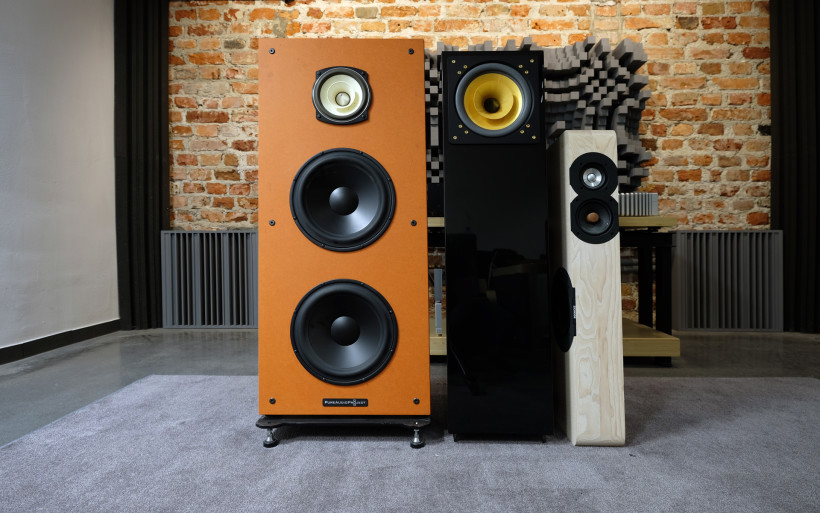 More interesting things happened in the midrange department and upwards. The Trio10 Voxativ sounded even smoother; it had contours emphasized slightly less, but the whole mid FR it displayed in poshier fashion; gentler, more subtle, not as immediate as Magus and slightly more distant and unearthly. Well-seasoned full-range aficionados would probably say that the Israeli product had an edge over Polish boxes here and I’d agree with them. It seemed to me that – at least as far as midrange sophistication goes – Holger Adler still knows more about full-range transducers than the Cube Audio team. The way it’s meant to be, eh? After all, the man’s been doing this for ‘quite a while’ now.
More interesting things happened in the midrange department and upwards. The Trio10 Voxativ sounded even smoother; it had contours emphasized slightly less, but the whole mid FR it displayed in poshier fashion; gentler, more subtle, not as immediate as Magus and slightly more distant and unearthly. Well-seasoned full-range aficionados would probably say that the Israeli product had an edge over Polish boxes here and I’d agree with them. It seemed to me that – at least as far as midrange sophistication goes – Holger Adler still knows more about full-range transducers than the Cube Audio team. The way it’s meant to be, eh? After all, the man’s been doing this for ‘quite a while’ now. In general I’d say that Magus was flashier so to speak, in the human age context several years younger and thus not as experienced yet. It was heard that it hasn’t lived as long and still sported somewhat jumpier, more intense and nervous attitude. Some life know-how was still to be gained, whereas Trio10 played it calmer and more refined. The former has been to places, seen and done things and now settled down finally to do some storytelling to youngsters about all of its adventures. Or, to put it simply, it was more seasoned and – again – poshier. These audible differences weren’t of night and day calibre though and the biggest one out there – the bass – we’ve already covered. Along with amplification needs, these are the most divisive factors. Let’s add the OB vs transmission line concepts’ clash on top all this and there you have it, apples and oranges and nothing less indeed. I’ll stop here though, the Israeli case is already in the works, more about this product you’ll be able to find out in the upcoming days, it’s highly likely that in 2017 still. Time to summarize.
In general I’d say that Magus was flashier so to speak, in the human age context several years younger and thus not as experienced yet. It was heard that it hasn’t lived as long and still sported somewhat jumpier, more intense and nervous attitude. Some life know-how was still to be gained, whereas Trio10 played it calmer and more refined. The former has been to places, seen and done things and now settled down finally to do some storytelling to youngsters about all of its adventures. Or, to put it simply, it was more seasoned and – again – poshier. These audible differences weren’t of night and day calibre though and the biggest one out there – the bass – we’ve already covered. Along with amplification needs, these are the most divisive factors. Let’s add the OB vs transmission line concepts’ clash on top all this and there you have it, apples and oranges and nothing less indeed. I’ll stop here though, the Israeli case is already in the works, more about this product you’ll be able to find out in the upcoming days, it’s highly likely that in 2017 still. Time to summarize.
Summary
Cube Audio Magus turned out to be a brilliant and very surprising product. Past the Zeth experience, this scribe expected nothing less than a proper fistfight. Clearly the joke’s on me as nothing of the sort happened. On the contrary in fact. To have speakers as easygoing to work with is a rare thing, but this good at the same time? Now that’s a luxury right there. Fortunately not very oftenly experienced and that’s probably for the best as it tends to switch the analytical/comparative mindset off and – bluntly speaking – spoils some of us journos…
Let’s talk money. The €7’990 ask for a pair of very regularly looking boxes and two transducers might be seen as unreasonable by many people. As Srajan put it in his Cube Audio Bliss C review’s summary, one can get more stuff for the same coin elsewhere and this writing’s hero isn’t any different. Polish Magus is as niche on the outside as it gets, hence its initial goal is to target a customer who’s already aware of what it is in the first place. This model operates in a very specific realm and will satisfy very specific audience, that’s true. But here’s the major upshot, though: as non-mainstream as it seems, said Polish product is a great crowd-pleaser nonetheless. Not only it’ll go nicely with most machines out there, but also sports all full-range virtues, delivers marvelous bass and sounds fantastic in general. Both well-seasoned vets and regular enthusiasts will find it very easygoing and utterly enjoyable. Full-range sophistication for masses? Quite. Such transducers related affairs can be very scary indeed, yet this review’s marvel being as friendly as possible is the exact opposite.
Cube Audio Magus turned out to be a champ not only in its own category, but in general. Yours truly would fare a perfectly happy life with it as it’s this good and complete. Many things it does right, nothing wrong and as such it will be remembered completely differently than its German competitor. Every aficionado in search of marvelous and friendly all-rounder should take Cube Audio’s latest model into serious consideration as it deserves this. It simply delivers. I look forward to what the future holds for the skilled local team and am very impressed by what they were able to accomplish thus far. From Poland with love yet again and ’till next time!
Associated equipment:
- Amplifier: Trilogy 925, Trilogy 993 + 903, FirstWatt F7
- source: Lampizator Golden Gate (Psvane WE101D-L + KR Audio 5U4G Ltd. Ed.)
- Speakers: PureAudioProject Trio10 Voxativ
- Transport: Asus UX305LA
- Speaker cables: Forza AudioWorks Noir Concept, Audiomica Laboratory Celes Excellence
- Interconnects: Forza AudioWorks Noir, Audiomica Laboratory Erys Excellence
- USB cables: DIY cable, generic 1€ cable
- Power supply: Gigawatt PF-2 + Gigawatt LC-2 MK2 + Forza AudioWorks Noir Concept/Audiomica Laboratory Ness Excellence
- Rack: Franc Audio Accesories Wood Block Rack
- Music: NativeDSD
Retail price of reviewed component in EU (incl. VAT):
- Cube Audio Magus: €7’990
Manufacturer: Cube Audio


